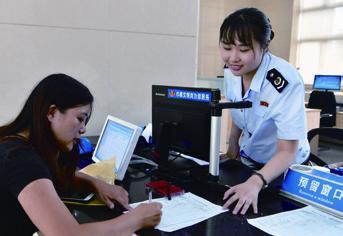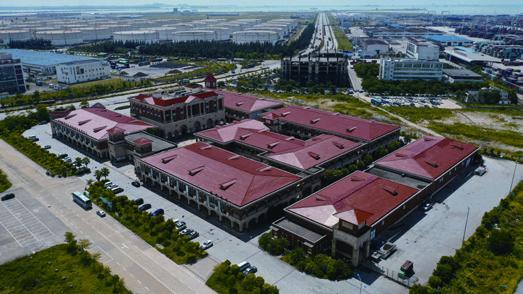Healthy,Resilient and Up
2019-11-05ByLiXiaoyang
By Li Xiaoyang

Amid concerns that Chinas economic growth may soften below 6 percent, data released by the National Bureau of Statistics (NBS) on October 18 showed that the country gained strength in the fi rst three quarters of the year to meet its annual growth target, although its economy continued to slow down in the third quarter (Q3).
The GDP registered a 6.2-percent growth year on year to about 69.7 trillion yuan ($9.8 trillion) during the period, according to NBS data, within the target range of 6-6.5 percent. In Q3, the GDP expanded 6 percent over the previous year, down from 6.4 percent in Q1 and 6.2 percent in Q2.
“Despite global economic slowdown, the growth in the January-September period met expectations and maintained within an appropriate range,” Zong Liang, chief economist of Bank of China, said at the Guoshi Forum on the Chinese economy, hosted by China News Service in Beijing on October 18.
The economic structure has steadily improved, but the economy still faces down-ward pressure and external uncertainties, NBS spokesperson Mao Shengyong told a press conference on October 18, adding that more efforts are needed to boost consumption and expand effective investment to enhance economic resilience.


Higher quality
A prominent highlight in Q1-Q3 economic performance laid in the stable job mar- ket, Wei Jianguo, Vice Chairman of the China Center for International Economic Exchanges, said.
NBS data showed that the number of newly added urban jobs across the country was 10.97 million, representing 99.7 percent of the annual target. The surveyed unemployment rate in urban areas stood at 5.2 percent in September, below the annual control target.
In addition, the per-capita disposable income reached 22,882 yuan ($3,225), with a real increase of 6.1 percent after adjusting for infl ation, in line with the GDP growth rate.
“The stable growth of employment amid economic slowdown can be attributed to industrial restructuring that is expanding the service sector and generating new industries,” Mao explained.
The value added of the service sector, which accounted for 54 percent of total GDP, rose 7 percent in the first three quarters, contributing 60.6 percent to GDP growth.
The secondary industry also registered stable growth, with a 5.6-percent year-on-year expansion in value added. Manufacturing output rose 5.9 percent, while hi-tech manufacturing led the overall growth with an increase of 8.7 percent.
Mao highlighted rebounds in the manufacturing industry as the manufacturing purchasing managers index (PMI) went up from 49.5 in August to 49.8 in September.“Although the reading remained under the boom-or-bust line of 50, the data suggests that both manufacturing production and market demand have seen expansion,” he said.
Recent rebounds in indicators such as the manufacturing PMI and infrastructure investment are positive signs, Mao said. With booming consumption, steady economic restructuring and effective supporting policies, China has the right conditions to maintain steady economic performance in Q4, he added.
Stability
Consumption, exports and investment have continued to serve as mainstays driving up the Chinese economy. According to NBS data, fi nal consumption expenditure contributed 60.5 percent to economic growth in the first three quarters, up 0.4 percentage point compared to the fi rst half of the year.
Retail sales of consumer goods, a gauge of consumption, rose 8.2 percent year on year nominally to about 29.6 trillion yuan ($4.2 trillion) during the period. With the exclusion of automobile sales, the growth rate was 9.1 percent.
A breakdown of the data showed the resilience of consumption growth, while the actual growth of retail sales of consumer goods stood at 6.4 percent, down from over 10 percent in the previous years, said Xu Hongcai, Deputy Director of the Economic Policy Commission, China Association of Policy Science.
“Notably, automobile sales continued on their downtrend. Therefore, much room for growth remains for China to expand consumer spending,” he told Beijing Review.
Data from the China Association of Automobile Manufacturers (CAAM) showed that vehicle sales dipped 10.3 percent to 18.37 million units year on year in the fi rst three quarters.
The new-energy vehicle (NEV) market was the only exception due to robust sales before the reduction of purchasing subsidies. According to CAAM, a total of 872,000 NEVs were sold in the fi rst nine months, up 20.8 percent year on year, with production surging 20.9 percent to 888,000 units.
Along with economic slowdown and trade uncertainties, policies on environmental protection have also exerted infl uence on the industry. Several provincial-level regions started implementing the China VI vehicle emission standards, which are some of the worlds strictest rules on automobile pollutants, in July.
Many auto enterprises have resorted to reducing production since applying upgraded technologies takes time, Chen Shihua, an assistant to secretary general of CAAM, said.

The good news is that the sluggish performance will not last long. As the decline in auto sales and production narrowed in Q3 under supporting policies, the domestic auto market may see a rebound in the following months, ac- cording to industry observers.
Trade and investment
Despite weak global economic growth and rising protectionist tide, Chinas foreign trade remained resilient in the fi rst three quarters, Li Kuiwen, a spokesperson for the General Administration of Customs of China, said at a press conference on October 14. Customs data showed that total imports and exports rose 2.8 percent year on year to 22.91 trillion yuan ($3.2 trillion), with exports expanding 5.2 percent to over 12 trillion yuan ($1.7 trillion).
Though the volume of imports dropped 0.1 percent, imported goods became more diversified, ranging from daily commodities to hi-tech equipment and components. Moreover, private enterprises made up 42.3 percent of total foreign trade, with their volume growing 10.4 percent year on year to 9.69 trillion yuan ($1.35 trillion), Li said.
Trade with the United States dropped 10.3 percent on an annual basis to 2.75 trillion yuan ($388 billion), while that with the EU and the Association of Southeast Asian Nations hit 3.57 trillion yuan ($504 billion) and 3.14 trillion yuan ($443 billion), up 8.6 percent and 11.5 percent, respectively.
Other countries participating in the Belt and Road Initiative accounted for 6.65 trillion yuan ($939 billion) of Chinas imports and exports, up 9.5 percent year on year, which was 6.7 percentage points higher than the overall foreign trade growth rate in Q1-Q3.
According to Wei, China needs to further boost imports to better meet domestic demand.
“Since many developed countries still occupy a large share in the global market, China should diversify trading partners and promote technological upgrade in domestic enterprises,” he said.
What has roused more concerns is the fact that growth in the investment sector was below expectations. NBS data showed that fixed assets investment grew 5.4 percent year on year in the fi rst three quarters, retreating 0.1 percentage point from the January-August period. Private investment increased 4.7 percent in the same period, compared to 4.9 percent for the previous eight months.

Total investment in property development jumped 10.5 percent year on year. According to Liu Hongyu, head of the Institute of Real Estate Studies under Tsinghua University, the policy of houses are for living in, not for speculation will continue to rein in the market.
Moreover, manufacturing investment, which grew 2.5 percent on a year-on-year basis, showed a downward trend. According to Mao, the slowdown indicates that the real economy still faces many diffi culties, making it necessary to improve the domestic business environment, enhance property rights protection and expand fi nancing support.
Encouragingly, investment in hi-tech manufacturing and hi-tech services grew 12.6 percent and 13.8 percent year on year, 7.2 percentage points and 8.4 percentage points higher than that of total investment, respectively.
“Targeted measures are needed to control investment in the property market and improve manufacturing for further industrial upgrade,” Zong told Beijing Review.
Bright outlook
To cope with the economic downturn, China has stepped up counter-cyclical adjustments, channeling more funds into the real economy and furthering opening up.
Since the beginning of the year, the government has rolled out a host of policies to cut taxes and fees, and increased the issuance of special bonds by local governments, Mao said.
According to the Ministry of Finance, tax and fee cuts exceeded 1.5 trillion yuan ($212 billion) in the fi rst eight months, further easing the burden on enterprises and increasing income and employment.
Meanwhile, efforts are being made to create a more open market, including unveiling updated negative lists for foreign investment market access and launching new pilot free trade zones. The revised administrative regulations on foreign-invested banks and insurance companies lift restrictions on the business scope of entities, further opening up the fi nancial sector.
The moves have increasingly made China a magnet for global investment. Offi cial data showed that foreign direct investment into the Chinese mainland rose 6.5 percent year on year to 683.21 billion yuan ($96.27 billion) in the fi rst three quarters.
In September, the growth of the consumer price index (CPI), the main gauge of infl ation, rose to a six-year high of 3 percent. At the same time, the producer price index(PPI), which measures costs for goods at the factory gate, dropped 1.2 percent.
“The rise of CPI in September was mainly caused by a recent increase in pork prices, which led to price hikes of other foods,” Wei said. In response, the government has released pork reserves to prevent rising prices from further weighing on consumers.
According to Xu, a rising CPI and a dropping PPI suggest neither inflation nor defl ation. The rise of pork supply can make its prices stable again in the fi rst half of 2020.
Upbeat about the economic performance in the remaining months of the year, Wei predicted that the Q4 GDP growth would hit 6.2 percent, partly attributable to the rebounding consumption during upcoming festivals and positive outcomes of the China-U.S. trade talks and the negotiations on the Regional Comprehensive Economic Partnership deal.
“Efforts should be stepped up to further boost consumption, support private enterprises and improve foreign trade of central and western regions through industrial transfer,”Wei said. “Still, the country needs to stabilize the renminbi and promote the internationalization of its currency amid a changing international economic landscape.”
